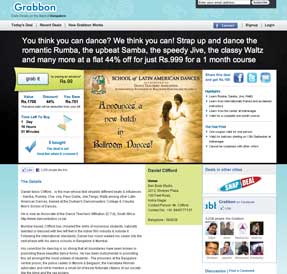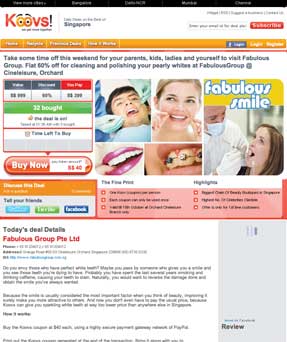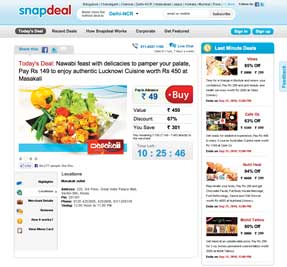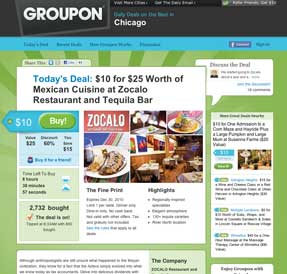Business
Group Buying Sites

Strategy of the Future or Too Good to Be True?
|
For Avanti Vishwanathan, a college student in Bangalore, a lavish brunch and a day relaxing by the pool at a five-star hotel is hardly a typical Sunday activity. With the help of a deal from Taggle.com, however, Vishwanathan may finally be able to afford the indulgence. The site offered a 50% discount on an $16 package to spend the day at the hotel pool with a three-course meal. The deal only went live if 30 people signed up over a three-day period to buy it.
Consumers can get a better price if they purchase in greater numbers; and that is the basic premise of group buying websites that have emerged in India and in other parts of the world in the past year. “Fundamentally, the concept is not new,” says John Kuruvilla, founder and CEO of the Bangalore-based Taggle Internet Ventures. “We are just using the power of the Internet as an aggregator to provide benefits to the consumer and the merchant.” For Kuruvilla, Indian consumers are the ideal “intrinsic gene pool for such a venture,” because frugality is part of the culture. “We are brought up to squeeze the last drop out of our toothpaste [tubes],” he notes. Taggle and competing sites such as SnapDeal, MyDala, Koovs, Deals and You, and Grabbon are the new face of e-commerce in India. Most are relatively young companies, but investors are opening their wallets to the businesses. Inventor and venture capitalist Vinod Dham’s firm funded SnapDeal with an undisclosed amount last year. Taggle recently received a combined $8.75 million in first-round venture capital funding from Greylock Partners and Battery Ventures, a firm that has also invested in American group buying site Groupon. Koovs is reportedly in the final stages of to stitching up its VC funding.
In addition to attracting a significant amount of investor funding, group buying sites are also generating M&A activity. In June, Delhi-based Jasper Infotech, which owns SnapDeal, bought Bangalore-headquartered Grabbon. The same month, Gurgaon-based Smile Interactive and Group Buying Global AG, which operates sites across four continents, bought Mumbai’s WanaMo.com (recently rechristened Deals and You.) Smile Interactive was founded by entrepreneur Harish Bahl, who also owns Fashion and You, a members-only online shopping site, and several other web properties. “Group buying in India as a business development and customer acquisition strategy makes an enormous amount of sense,” suggests Eric K. Clemons, professor of operations and information management and management at Wharton. “In a mature market, you can’t really separate business development from discounting because, for instance, the number of Americans going to restaurants is not going to change dramatically. But the middle-class population in India is exploding. In a developing market, you can most certainly focus on business development and have a short-term strategy for each merchant.” Waiting for Take-Off
But e-commerce in India has yet to take off. With the exception of travel-related websites, few companies have succeeded in the sector, in part because broadband connectivity is poor in many parts of the country and a significant number of consumers are still wary of using credit cards on the Internet. “With travel, consumers [buy an experience that takes place] offline,” maintains Anisha Singh, founder and CEO of Mydala.com, a group buying site which started in Delhi and Mumbai in November 2009. “The group buying model lends itself to something similar.” In India, she adds, there is suspicion of a product that has to be shipped, even something as basic as a cake or flowers. Offline experiences, such as a day at a fancy hotel, don’t have to be sent through the mail. Thus, the most common types of offers on most group buying sites are deals on retail services, the most popular being restaurants, spas and salons, and weekend getaways. “The retail market in India is estimated to be close to $500 billion, of which 17-18% is services. Even if we can take 0.5% or 1% of that market online, that is a sizeable market,” notes Kunal
Bahl CEO of SnapDeal parent firm Jasper Infotech. “People make the mistake of estimating the market based on the number of transacting users [currently] on the Internet, the percentage that buys every quarter and so on. Revolutions don’t happen that way.” According to Bahl, Jasper-owned group buying sites have accumulated 350,000 registered users in just over six months of operations. Bangalore-based Taggle has crossed 100,000 fans on Facebook in two months. MyDala reports 150,000 users across nine cities and claims to have saved them over $200,000 so far. The Bangalore-headquartered Koovs, which also operates across several Indian cities, has expanded internationally to Singapore and Thailand. According to Google’s DoubleClick advertising arm, as of the end of August, the number of unique visitors for Indian group buying sites was: SnapDeal (290,000), MyDala (43,000), Deals and You (36,000), Koovs (27,000), Taggle (19,000), and Grabbon (10,000). Group buying sites are trying to bring customers together socially, in addition to harnessing the bargaining power of groups. That’s where social networking sites like Twitter and Facebook come in. Taggle’s Kuruvilla says the company’s social networking strategy was to target “the top-end of the pyramid, early-adopters of e-commerce, which has given us good traction.” According to Kuruvilla, the percentage of Facebook followers that actually convert to users is in “significant double-digits.” Growing from Groupon
Groupon’s success has spurred much of the action in the group buying arena, suggests venture capitalist Mahesh Murthy, managing partner of Seedfund. The Chicago-based website, which launched in November 2008 and offers deals to customers in Europe and the United States, received a valuation of $1.35 billion in a fourth round of financing from Digital Sky Technologies and Battery Ventures in April. Sites in India are vying to be the first to capture that kind of success; the added incentive, as Wharton’s Clemons points out, is that India could ultimately be a more fertile ground for group buying than Western markets. “All the existing websites [in India] have been set up to be Groupon clones,” Murthy maintains. He has doubts about the economics of the business model. “Even if you have 5,000 deals a day worth $1 each, at $150,000 each month you’re barely making a profit. It’s going to be a death march where the entrepreneur is going to get rich off the VC’s money, the VC is going to [lose money] and, at the end of the day, very little discernible value is going to be created for the consumer.” Group buying sites are attracting significant investment, but they also benefit from a relatively simple business model, experts note. The websites feature promotions with a predetermined discount and a minimum number of buyers. The limited time period creates a sense of urgency, prompting impulse purchases. All interested buyers must provide their credit card information, but are only charged if the deal goes live. Little money is locked up in working capital because the group buying website either bills the entire amount of the purchase upfront and retains a commission before passing the rest of the payment onto the merchant, or charges a token amount and directs the user to pay the rest at the merchant’s site.
If the deal does not materialize, the group buying site isn’t stuck with any back inventory because the discounted service or item is sourced at the participating business. Buyers receive vouchers for their purchases via e-mail or text message and they have anywhere from one to three months to redeem the offer. Developers of group buying sites count on users encouraging friends or acquaintances to participate in an offer in order to accrue the minimum number of buyers needed to unlock a deal. Users promoting the deals on Twitter or Facebook provide the sites with free viral marketing. But the positives can add up to a big negative, experts warn. There are very few barriers to entering the sector and too much competition could destroy the game. These sites today get a 20% average margin on deals. But with clones everywhere that number could get squeezed as merchant establishments play one off against the other. Finding the Right Customer The goal for most players is to reach Groupon’s reported 50% margins. SnapDeal’s Bahl predicts that “margins will expand because suddenly the merchant’s dependency on us will go up. All our merchants want to come back.” He gives the example of a whitewater rafting company in North India that booked its entire season in 36 hours after a discount was offered on SnapDeal. Shelley Thayil, director of operations for Bangalore-based Paul Resorts and Hotels, says a promotion with Taggle helped the company sell 540 vouchers in three days when it was trying to enter a new market. “Some 80% of [the buyers] redeemed the offer,
which is good business.” Additionally, Thayil could accurately measure his cost of acquisition per customer as opposed to traditional advertising. In spite of the successful promotion, Thayil is unlikely to make group buying a permanent component of his marketing plan, “There is always the danger of being seen as a discount player,” he points out. “That’s a fine line you have to tread.” Rajesh Srimalani, marketing manager of Amore Gourmet Gelato, sold 546 vouchers for 50% off one scoop of gelato in four days on MyDala. But execution hiccups left him leery of doing it again. “We faced a lot of duplication issues [because] the same voucher could be showed at multiple outlets,” he notes. “Additionally, our staff needed to be trained for [to process the vouchers], and a whole gamut of things had to be in place for such a promotion. That’s where we take a blow.” To counter such issues, Taggle has devised hologram vouchers that it couriers to users at its own cost. The existing websites vary in their average deal prices ($5 to $36) and average discounts (50% to 70%). “We would never feature high-end services on SnapDeal,” Bahl notes. “The heart of Indian retail is long-tail [small and medium enterprises].” MyDala’s Singh echoes Bahl’s comments, saying that site is also unlikely to stray from focusing on “the mom-and-pop merchant clientele. The bigger players have the requisite strength and can spend more marketing dollars. The smaller merchants need us more.”
Taggle’s Kuruvilla disagrees, however. “If you give the customer value, and are completely transparent, he will find you. They’re even buying diamonds on our site.” Rajiv Mehta, CEO of Surat Diamonds, an online jewelry retailer, says that a promotion on a group buying site for a 50% discount on diamond jewelry netted his business 38 new customers. “Being on a group buying site does not affect my brand equity,” he maintains. “India is a value-proposition country and deals make customers happy. A happy customer will refer us to others.” Knowing that the proliferation of copycats might be the sector’s downfall, some sites are making efforts to get into new lines. Koovs plans to offer health care packages in partnership with Apollo Hospitals and Nova Medical Center. Deals and You has sister site Fashion and You, which is an invitation-only discount seller of upmarket labels. For others, like Bahl of SnapDeal, the average number of vouchers per deal sold is the primary determinant of future success. “You have to look at the quantum when you collaborate with merchants,” Bahl points out. ‘Too Good to be True?’ Even for websites operating in a virtual space, doing business in India comes with inherent hazards. “Technology is a hindrance. Close to 30% of transactions fail at the payment gateway,” says Kanishk Shukla, co-founder of Koovs. Indian payment gateways, unlike those in the United States, don’t allow users to store their credit card information. Hence Shukla and others are developing prepaid cards and experimenting with cash-on-delivery options. Payment via mobile phone is also being explored. “With 550 million subscribers, mobile play is an extremely important part of the business,” adds Shukla. A different challenge involves consumer education. “Sometimes consumers in India feel that, if something is 80% off, it might be too good to be true. That’s actually a bigger challenge for us than merchant management,” maintains SnapDeal’s Bahl. It’s unclear if offering products and services at such deep discounts will permanently alter what shoppers perceive as “fair value.” “We’ve known for a decade that couponing, in whatever form, as an acquisition strategy can’t be sustainable,” Wharton’s Clemons points out. “You end up giving everything away. At some point, almost by definition, this has to cannibalize your existing business. If you give more and more business away at cost, consumers are trained to expect it at cost. At some point, you have to charge more. Somebody has to provide your profit.” If businesses increase their prices, however, customers have an incentive to wait for a discount. “Ultimately, it’s a disaster,” Clemons adds.
Seedfund’s Murthy compares group buying with the low-cost aviation industry in India. “Air Deccan is a perfect example of localized hara-kiri,” he notes, referring to the low-cost airline that offered tickets as low as $10 to fill empty seats. “I don’t understand the power-of-numbers concept. Boeing is not selling Air Deccan planes at one-tenth the cost; Hindustan Petroleum is not selling aviation fuel at one-tenth the cost. So what makes Air Deccan sell tickets at one-tenth the cost? You may say it’s a perishable commodity. But if you do your math, it’s not going to work out. You can’t flout the basic laws of economics; you can’t sell at one-tenth the price and make it up with 10 times the volume. Yes, Air Deccan [which has since been acquired by another airline] opened up the market, but it killed itself in the process.” Group buying in India will certainly evolve, but Murthy predicts that those sites that survive will be “winning by attrition, with the last man standing being the one who has burnt the most money.” But for MyDala’s Singh, “the current model itself is not a self-sustaining one. It’s an enabler toward a happy middle ground in terms of a social commerce platform.” Clemons also views group buying more as a “transition strategy” toward ultimately working directly with customer data. “The websites probably have a 10-year run of extra profitability in business development for their clients,” he suggests. “After 10 years of having a better working relationship with service establishments in various cities, and after having the data on their most loyal customers, I’ll be really surprised if there is nothing we can do with the database.”
|









